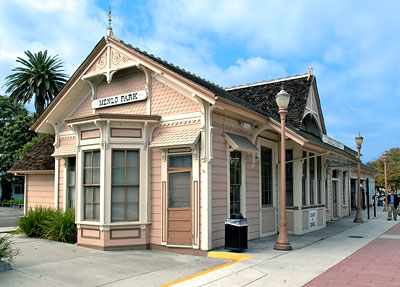National Register of Historic Places in San Mateo County
Menlo Park Railroad Station
1100 Merrill Avenue
Menlo Park
Built 1867
The Menlo Park Railroad Station combines, in a graceful whole, many different elements representative of wooden architecture in the San Francisco Bay Area from the 1860's to the 1890's.
The original building of 1867, whose roofline and overall form remain intact today, is a fine example of the simplified picturesque cottage style of the 1850's and 1860's. In the 1880's and 1890's, the station was updated with the addition of more extensive and elaborate decorative elements: brackets, mouldings, and gable-ornamentation typical of the Stick Style and shingled surfaces and over-windows representative of the Shingle Style.
As a result, the building is like a survey of architectural styles of the period, a charming document of the changing, fanciful taste of the late nineteenth century.
Built by the San Francisco and San Jose Railroad (SF&SJ) and opened for business on 30 March 1867, it is one of the earliest existing railway statibns in California. Early in 1868, the company which would become the Southern Pacific purchased SF&SJ extended the line southward, eventually to develop the Central Valley and Southern California.
Adapted from the NRHP nomination dated 1 October 1974.

In the 1850's, the region which is now Menlo Park was being transformed from grazing land and thickets under giant oak trees into farms. Two Irishmen, Dennis Oliver and D. C. McGlynn, purchased a 1,700 acre tract and named it after their birthplace on the outskirts of Galway, a town named Menlough. Their new homesite was Menlo Park, and, to identify it, they built a large wooden gateway with the name painted in foot-high letters over the central arch. When the railroad station was built nine years later, the gate was a landmark, hence the building was located nearby and given the name Menlo Park.
The coming of the railroad marked the beginning of a double transformation: the growth of a town and the development of a countryside filled with fashionable estates and beautiful grounds. In 1863, as the line was being constructed, the Menlo Park Villa Association advertised 800 acres in villa lots of not less than five acres. The tract was a three-hour drive from San Francisco, but the new railroad could bring passengers from the City in eighty minutes
Many prominent citizens, attracted by the natural beauty and mild climate of the area, came down to purchase or build stately country homes. Timothy Hopkins, James C. Flood, Edgar Mills, William Sharon, Charles N. Felton, and Leland Stanford were all prominent residents.
Stanford, Governor of California and later U. S. Senator, began purchasing acreage in the 1870's and built a summer home on the banks of San Francisquito Creek. Although the Stanford home was just across the San Mateo County boundary in Santa Clara County, the Menlo Park Station was their station, and the family was very much a part of the Menlo community. After the tragic death of their only son, the Stanfords determined to create a lasting memorial by founding a university on the vast landholdings of their Palo Alto farm.
The opening of Stanford University in 1891 was a major event. The building had brought an array of architects, stone cutters, masons, landscape gardeners, and various technicians. Numerous professors as well as students lived in the village of Menlo Park, and all came and went from the Menlo Park Station.
The depot held the first telephone exchange for the area in 1884 called the Sunset Telephone and Telegraph Company. By 1888, there were ten subscribers to the service.
Adapted from the NRHP nomination dated 1 October 1974.

The Menlo Park Railroad Station is also California Landmark 955.

Burlingame
Keeler
Menlo Park
Millbrae
San Carlos
Valley Springs
